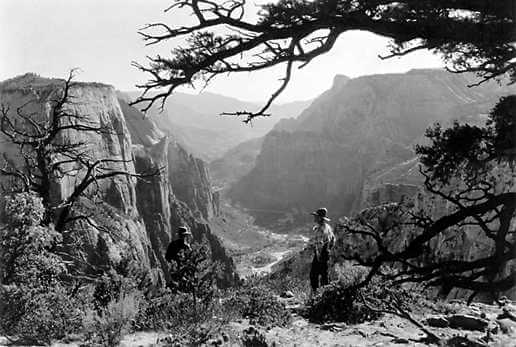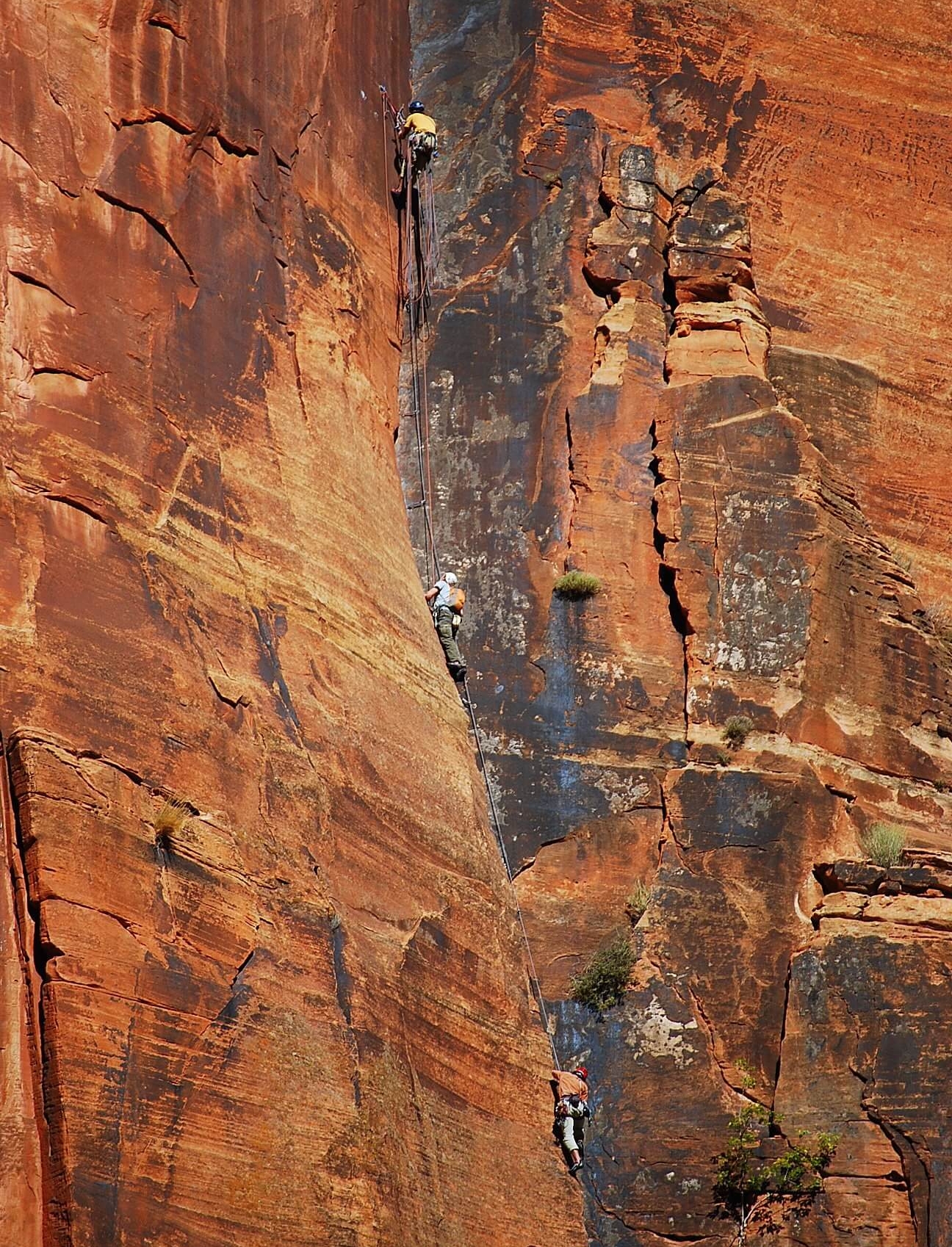A confluence of cultures
Zion Canyon is at the edge of the Colorado Plateau where it meets the Basin and Range region. Being at this point geographic inflection, it also has been near the intersection of human cultures for centuries. For more information about the human history of Zion, you can visit the Zion Human History Museum in the Park.
Parunuweap ruins
A prehistoric structure in Parunuweap Canyon. Image via the National Park Service.
Native people: the Pueblo & Paiute
Ancestral Pueblo Indians (aka Anasazi, aka Mokis) lived in Parunaweap canyon from 500 AD to about 1300 AD. These settlements were the furthest west Anasazi villages, and were somewhat isolated from the main culture, developing unique styles.
When the first white settlers arrived in the 1860's, Southern Paiute Indians inhabited the area. The Paiutes shunned Zion Canyon as a place of mysterious happenings - not a good place to be after dark! Many Zion place names come from Paiute theology including Mount Wynopits (after Wynopits, the God of Evil) and Mount Kinesava (after Kinesava, the Trickster).
Pioneers arrive
Guided by a friendly Paiute, Nephi Johnson was the first pioneer to visit Zion Canyon in November 1858, riding in as far as the Great White Throne and perhaps to the Narrows. He returned to the Virgin River valley a month later with a settlement group and founded the town of Virgin. The next wave of settlers led by Orson Pratt arrived in December 1861, settling Rockville and Shunesberg, three miles east of Rockville on the East Fork of the Virgin River. Springdale was established in the fall of 1862, the town laid out and irrigation ditches dug. By 1864, an LDS church census counted 765 persons living in the Upper Virgin valley, from Virgin to Springdale.
East Rim Horse Party
A crew traveling through Zion, circa 1929. Image via USGS Photo Archives.
Photographer George A. Grant.
The first of the new settlers to visit upper Zion Canyon was Joseph Black, who made the arduous exploration in 1861 or 1862, and talked up the glories of the canyon to the unbelieving pioneers. He did, however, catch the interest of Isaac Behunin, who visited upcanyon in the summer of 1863, built a summer cabin near the present day site of Zion Lodge, and planted a few crops. By 1864, the Behunins had dug an irrigation ditch and placed several acres under cultivation, for corn, fruit trees and tobacco.
Within a few years, William Heap (or Heaps) and John Rolf had settled their families in the same area, though they wintered in Springdale, as did the Behunins. John Rolf built two houses, one down by the Behunins and one up by the Grotto.
Isaac Behunnin (later Behunin) was born in Oswego County, New York in 1803, and baptized into the LDS Church on New Year's Day, 1833. He soon moved to Kirtland, Ohio, and later (1837) to Randolph County, Missouri. He was with the Saints through numerous persecutions in Missouri, escaping to Nauvoo, Illinois in 1839. Thence to Winter Quarters, then to Salt Lake City in 1848. He was the first settler in Ephraim, Utah, helping found the town in 1852. He was called upon by the church elders to help settle Springdale in 1862. By the time he got to Zion Canyon at the age of 60, he was ready for a little rest and respite. Isaac is oft-quoted as naming Zion, reflecting on the LDS Temple being built in Salt Lake City:
“These are the Temples of God, built without the use of human hands. A man can worship God among these great cathedrals as well as in any man-made church - this is Zion.”
The first wagon road into the upper canyon was constructed in the winter of 1864-65. The years of 1866 and 1867 were less idyllic, as fighting broke out in southern Utah between the settlers, the Paiutes and the Navajo. The pioneers concentrated into Springdale, then to Virgin, for better defense, and outlying fields were tended by armed parties. With the arrival of peace in 1868, the former prosperity was gradually restored. Isaac Behunin left Zion Canyon in 1874 to join the United Order in Mount Carmel, and helped found the town of Orderville, where he died in 1881.
John Wesley Powell visited the area in 1872, making the first modern descent of the East Fork of the Virgin River (Parunaweap Canyon). His party left the village of Mount Carmel on September 10th, spent an uncomfortable night in the canyon and arrived at the settlement of Shunesberg the next day.
The same year, 1872, geologist and explorer Grove Karl Gilbert, working with the Wheeler survey, led the first European-American party down the North Fork of the Virgin from Navajo Lake through the Narrows to Zion Canyon. Major Clarence Dutton, working for the 1875 Powell Survey, visited Zion and waxed poetic about the view:
“In an instance, there flashed before us a scene never to be forgotten. In coming time it will, I believe, take rank with a very small number of spectacles, each of which will, in its own way, be regarded as the most exquisite of its kind which the world discloses. The scene before us was The Towers of the Virgin.”
The Cable
In the meantime, Mormon settlers were prospering in Springdale and the surrounding communities. Timber was needed for building houses, but not available locally. David Flanigan remembered great stands of timber up on the East Rim; and in 1900, unable to convince others of the practicality of lowering timber on a cable, packed 50,000 feet of wire to the top of Cable Mountain. His job was made easier by John Winder's 1896 work on the old Indian trail up Echo Canyon (now the East Rim Trail) making it barely passable to horses Over the course of three years, Flanigan perfected a rig for lowering timber and, in 1904, hauled an old sawmill to the top and began operations. By Christmas 1906, 200,000 feet of milled lumber had been lowered on his cable.
The sawmill was located at what is now Stave Spring. At the height of operations, between 30 and 45 men were employed, and lived in the summer, with their families, up by the mill. “Riding the Wire” both up and down became commonplace after 1910, when Quimby Stewart, part of a group sent in to survey the area for the National Monument, made the descent for a reward of watermelon. The ride took two or three minutes.
The cable was used for lowering lumber for the building of Zion Lodge in 1924, but this was the last big contract. The cable was dismantled in 1930, after the death of Springdale schoolteacher Mr. Brooksby, clocked on the head by a sliding piece of iron while chasing one of his charges off the bottom towers. The parking lot at Weeping Rock is located where the bottom towers used to be.
While the writings of John Wesley Powell and other explorers sparked interest in the West, the beauties of Zion were lost in a vast river of churning prose. National interest in Zion Canyon was enflamed by the efforts of Frederick S. Dellenbaugh, a member of John Wesley Powell's second Grand Canyon float trip. Dellenbaugh visited Zion Canyon in 1903, took photographs and painted a few paintings. His article and photos in the January 1904 Scribners' Magazine created a sensation, as did the exhibit of his paintings at the St Louis 1904 World's Fair.
LEFT: Atop Cable Mountain. Image courtesy the National Park Service.
A National Park: From Mukutuweap to Zion
The nation was growing up rapidly, and with the invention of the automobile and increasing prosperity, interest grew in the new leisure activity of tourism - and touring the scenic wonders of the American west. The National Park System was created in this era - Zion being added as Mukuntuweap National Monument July 31, 1909; then expanded and renamed Zion National Monument in 1918. By act of Congress, it became Zion National Park on November 19, 1919.
Frederick Vining Fisher, Methodist minister of Ogden, Utah, visited Zion in September 1916. Shown Zion canyon by the son of the Rockville LDS Bishop, the two played a game of naming the scenic points as they traveled up-canyon. Returning in the late afternoon, Fisher was awe-struck by a great monolith gleaming in the late afternoon sun - which he named The Great White Throne.
Southern Utah was promoted as a scenic destination. The WW Wylie Company ran auto tours from the railhead at Cedar City, through Zion to the North Rim of the Grand Canyon and back to Cedar, operating a tent camp at the site of the Zion Lodge. President Warren G Harding visited Zion on June 27, 1923 on his one-way trip to Alaska.
Click on the images below for more information...
All this interest led to better roads as automobiles started to transform the nation. A connection between Mount Carmel and Zion canyon was desired - but the terrain was difficult. John Winder, builder of the East Rim Trail and current operator of the Cable Mountain lumber operation, thought he had the perfect place for it. He proposed a road up Pine Creek, then punching a tunnel right through the Great Arch. The engineers were unimpressed, but realized a road up the south side of Pine Creek and through the cliffs above might just be feasible. The mile-long Zion-Mount Carmel tunnel was started in 1927 and completed in 1930. It was an engineering marvel.
In Zion canyon, the road was extended from the base of the cable to the Temple of Sinawava in 1925. The Gateway to the Narrows trail was built that same year, as was the West Rim Trail, the Lady Mountain Trail, and a trail along the west bench under the cliffs. The following year, the trail to the tip of Angels Landing was completed, plus two suspension bridges over the river. The West Rim Trail was worked on some more, and the East Rim Trail was upgraded to its current condition. The steep trail up Lady Mountain became problematic for the Park Service, due to the large number of people that became stranded, and was closed in the sixties.
Zion Lodge was built with the cooperation of the Union Pacific Railroad, opening in 1925. The original main building burned to the ground in 1966, and a replacement was built in 108 days. The replacement was described as "hideous", but was partially restored to the original lodge plans in 1992.
Rock Climbing in Zion
Climbing came to the area in 1927 with the first recorded ascent of the Great White Throne by "daredevil" William H Evans on June 27th via the south face. He built a fire on the summit to prove his accomplishment, but did not return to the valley the next day. A rescue team was organized and found him several days later lying at the base of the upper cliffs, bruised and delirious. The rescue effort led to the discovery of Hidden Canyon, and a trail was constructed to it the next year.
The Great White Throne was climbed again by Dan Orcutt in June 1931. Walter Becker, Fritz Becker and Rudolph Weidner climbed Cathedral Mountain on August 31, 1931. Other early peaks climbed include the West Temple (1933), the East Temple (1937) and the Sentinel (1938). Modern climbing came to Zion with the 1967 ascent of the Northwest Face of the Great White Throne by Fred Beckey, Galen Rowell and Pat Callis, after extensive wrangling for permission from the Park.
Canyoneering history is more obscure, as from the beginning, canyoneers did not record their descents. Mystery Canyon and Goose Creek were descended in the sixties, as was the Right Fork of North Creek. Royce D. Trapier forged many descents of local canyons including Pine Creek, Keyhole, Echo and Behunin. Dennis Turville explored much of the Zion backcountry in the seventies, and Norman Harding and Royce D. Trapier descended the last of the main canyons, Heaps, through the narrows in October 1982.
RIGHT: Climbers in Zion, courtesy of the National Park Service.
There are many additional resources for Zion's history, including the National Park Service website as well as the Zion Human History Museum within the Park.

















